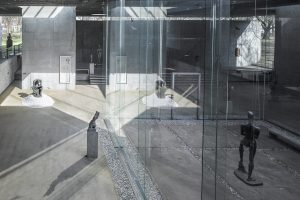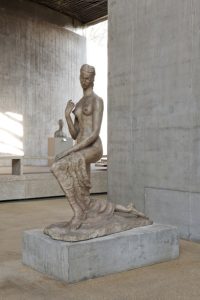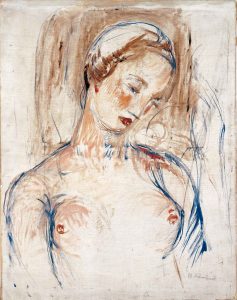Work
Alongside Ernst Barlach (1870–1938), Wilhelm Lehmbruck (1881–1919) is now considered the most important sculptor of German Classical Modernism. In the space of only two decades he created an exceptionally expressive and comprehensive oeuvre. Large parts of the collection are on view as a permanent exhibition in the Lehmbruck Wing, while temporary exhibitions complemement the presentation of his works.

Look into the Lehmbruck Wing, Photo: Dejan Saric
Sculptural work
Wilhelm Lehmbruck created his early sculptural work between 1898 and 1906. In essence, it reflects the stylistic pluralism of the turn of the century, something Carl Janssen, his tutor at the Düsseldorf art academy, acquainted Lehmbruck with during his student years. Inspired first and foremost by his exploration of the works of Auguste Rodin and Aristide Maillol, Lehmbruck found his own sculptural style even before relocating to Paris in the year 1910: These early works show withdrawn, spiritualized figures structured tectonically according to strict proportions yet assuming graceful poses.
During his years in Paris (1910 through to 1914) Lehmbruck heightened the expression of his ideal-typical figures by stretching their bodies upwards and outwards. Characterized by his contemporaries as “Gothic”, with his figures in plaster, cast stone and terracotta – occasionally also in the more expensive materials bronze and marble – came Lehmbruck’s international break-through as a modern artist: In 1911, he presented his Kneeling Woman at the Salon d’Automne in Paris, and two years later was the only German sculptor to be represented in the Armory Show touring the US (New York, Boston, Chicago), likewise with this piece.

Wilhelm Lehmbruck, Kneeling Woman, 1911, Photo: Jürgen Diemer
After the outbreak of the First World War I in 1914 Lehmbruck returned to Berlin. In subsequent years the tectonic element in his work gave way to a more expressive, fragmentary and reduced approach. In his years in Berlin and Zurich before 1918-9 he created the existential anti-war sculptures The Fallen and Seated Youth, sensitive and harrowing figures imbued with melancholy and loneliness, lending expression to a deep-seated desire for love and brotherliness, inner peace and a paradisiacal world.
Painting
Alongside his sculptures, Lehmbruck also created an extensive painterly oeuvre in his Parisian years that includes portraits, nudes and group compositions that address the harmonious and yet conflict-laden relationship between the sexes. Stylistically, these paintings lead to the moving, graphic expressionism of recent years.

Wilhelm Lehmbruck, Portrait of a Woman, 1912, Oil/tempera on canvas, Photo: Bernd Kirtz
Prints
In Paris Lehmbruck also produced almost 5,000 prints, etchings for the most part, in which he developed a distinct iconography, as well as addressing the themes of his sculptures. His use of the etching needle and the paper when printing was energetic and unconventional, while he repeatedly changed the state of these works.
Drawings
Lehmbruck’s drawings forged a link between his output in the different artistic media, yet also stood as works in their own right. In them he searched for the ideal shape through many lines, combining this with a delicate expressiveness. In summary, with his work after 1910 and through the metaphysical tectonics and abstracting expressivity he developed, Lehmbruck provided an early and essential contribution to the modern image of humanity in the art of the early 20th century.